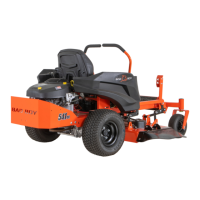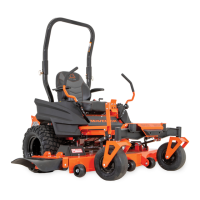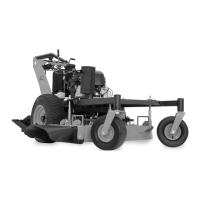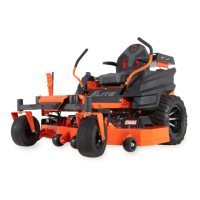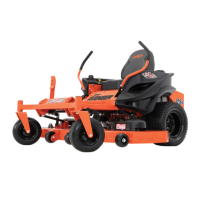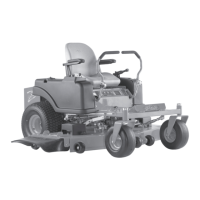Do you have a question about the Bad Boy BMZ4219BG and is the answer not in the manual?
Process and requirements for registering the mower's warranty within 30 days of purchase.
Locating and understanding the mower's model and serial numbers for parts ordering.
Recommendations for using genuine Bad Boy parts and locating authorized dealers for service.
Explanation of the warranty rights and obligations for the evaporative emission control system.
Essential safety instructions for operating the mower, including personal protection and environmental awareness.
Guidelines and warnings for operating the mower on inclines and slopes to prevent accidents.
Measures to prevent tragic accidents involving children during mower operation.
Safety guidelines for towing equipment and general service practices.
Procedure for testing the mower's safety interlock system to ensure proper function.
Information on operating the mower safely with optional ROPS, including usage and maintenance.
Step-by-step guide for starting, operating, and maneuvering the mower safely and effectively.
Daily, hourly, and annual maintenance checks and tasks listed with corresponding sections.
Recommendations for safely storing and transporting the mower, including fuel and securing methods.
Answers to common questions regarding mower performance, starting issues, and blade engagement.
Guidance on the type of fuel to use, octane rating, and ethanol content limitations.
Instructions for cleaning the mower to prevent fire hazards and maintain performance.
How to use the three-position ignition switch to start and stop the mower.
Adjusting engine speed using the throttle control lever.
Operating the choke control for starting a cold engine.
Using the control levers for steering, acceleration, deceleration, and direction changes.
Engaging and disengaging the mower blades using the PTO switch.
Setting the desired cutting height for the mower deck.
Using the parking brake to secure the mower in place.
Understanding the electronic hour meter for tracking engine run time.
Safe methods for moving a mower that cannot be operated normally, including using a winch.
Essential safety rules and steps for checking, sharpening, or replacing mower blades.
Instructions on greasing fittings, including type of grease and procedure for lubrication.
Understanding standard (2-in-1) and mulching (3-in-1) blades for optimal grass cutting.
Tips for achieving an even cut, maintaining grass health, and efficient mowing patterns.
Considerations for managing grass clippings, including benefits and composting advice.
How to use neutral bypass rods to move the mower when the engine is not running.
Adjusting mower tracking by altering pushrod length for transaxle speed.
Procedure for adjusting and checking the drive belt tension using a belt tension gauge.
Step-by-step guide for changing the engine oil and oil filter, including recommendations.
Instructions for replacing the fuel filter, noting fuel flow direction and using new clips.
Locating and operating the fuel shutoff valve.
Importance of air cleaner inspection and procedures for changing the air filter element.
Guide for changing spark plugs, checking the gap, and proper torque specifications.
Information on mower fuses, their locations, and warnings against improper replacement.
Schematic diagram illustrating the mower's electrical connections and components.
Torque requirements for front fork nuts and rear wheel lugs.
Identification of grease fittings on the pump belt tensioner, deck belt tensioner, and control arm blocks.
Steps for safely removing the cutting deck belt.
Procedure for correctly installing the cutting deck belt, ensuring proper routing.
How to adjust and check the deck belt spring tension for optimal performance and belt life.
Importance of sharp blades and recommendation for professional sharpening.
Step-by-step guide for leveling the mower deck, including tire pressure and pitch adjustment.
Instructions for removing mower blades, including tool requirements and torque for re-installation.
How to adjust the striping kit's rubber flap for desired lawn striping results.
A log for recording dates, operating hours, and performed maintenance tasks.
Blank space for user to record additional notes and observations.
What the warranty covers, for how long, and exclusions for material and workmanship defects.
Steps for obtaining warranty service, including proof of purchase and authorized centers.
Limitations on implied warranties, liability for incidental damages, and conditions for warranty validity.
Ensuring the selling dealership registers the mower for warranty validation.
Contact details for technical support, warranty inquiries, and parts department.
Process and requirements for registering the mower's warranty within 30 days of purchase.
Locating and understanding the mower's model and serial numbers for parts ordering.
Recommendations for using genuine Bad Boy parts and locating authorized dealers for service.
Explanation of the warranty rights and obligations for the evaporative emission control system.
Essential safety instructions for operating the mower, including personal protection and environmental awareness.
Guidelines and warnings for operating the mower on inclines and slopes to prevent accidents.
Measures to prevent tragic accidents involving children during mower operation.
Safety guidelines for towing equipment and general service practices.
Procedure for testing the mower's safety interlock system to ensure proper function.
Information on operating the mower safely with optional ROPS, including usage and maintenance.
Step-by-step guide for starting, operating, and maneuvering the mower safely and effectively.
Daily, hourly, and annual maintenance checks and tasks listed with corresponding sections.
Recommendations for safely storing and transporting the mower, including fuel and securing methods.
Answers to common questions regarding mower performance, starting issues, and blade engagement.
Guidance on the type of fuel to use, octane rating, and ethanol content limitations.
Instructions for cleaning the mower to prevent fire hazards and maintain performance.
How to use the three-position ignition switch to start and stop the mower.
Adjusting engine speed using the throttle control lever.
Operating the choke control for starting a cold engine.
Using the control levers for steering, acceleration, deceleration, and direction changes.
Engaging and disengaging the mower blades using the PTO switch.
Setting the desired cutting height for the mower deck.
Using the parking brake to secure the mower in place.
Understanding the electronic hour meter for tracking engine run time.
Safe methods for moving a mower that cannot be operated normally, including using a winch.
Essential safety rules and steps for checking, sharpening, or replacing mower blades.
Instructions on greasing fittings, including type of grease and procedure for lubrication.
Understanding standard (2-in-1) and mulching (3-in-1) blades for optimal grass cutting.
Tips for achieving an even cut, maintaining grass health, and efficient mowing patterns.
Considerations for managing grass clippings, including benefits and composting advice.
How to use neutral bypass rods to move the mower when the engine is not running.
Adjusting mower tracking by altering pushrod length for transaxle speed.
Procedure for adjusting and checking the drive belt tension using a belt tension gauge.
Step-by-step guide for changing the engine oil and oil filter, including recommendations.
Instructions for replacing the fuel filter, noting fuel flow direction and using new clips.
Locating and operating the fuel shutoff valve.
Importance of air cleaner inspection and procedures for changing the air filter element.
Guide for changing spark plugs, checking the gap, and proper torque specifications.
Information on mower fuses, their locations, and warnings against improper replacement.
Schematic diagram illustrating the mower's electrical connections and components.
Torque requirements for front fork nuts and rear wheel lugs.
Identification of grease fittings on the pump belt tensioner, deck belt tensioner, and control arm blocks.
Steps for safely removing the cutting deck belt.
Procedure for correctly installing the cutting deck belt, ensuring proper routing.
How to adjust and check the deck belt spring tension for optimal performance and belt life.
Importance of sharp blades and recommendation for professional sharpening.
Step-by-step guide for leveling the mower deck, including tire pressure and pitch adjustment.
Instructions for removing mower blades, including tool requirements and torque for re-installation.
How to adjust the striping kit's rubber flap for desired lawn striping results.
A log for recording dates, operating hours, and performed maintenance tasks.
Blank space for user to record additional notes and observations.
What the warranty covers, for how long, and exclusions for material and workmanship defects.
Steps for obtaining warranty service, including proof of purchase and authorized centers.
Limitations on implied warranties, liability for incidental damages, and conditions for warranty validity.
Ensuring the selling dealership registers the mower for warranty validation.
Contact details for technical support, warranty inquiries, and parts department.
| Engine | Briggs & Stratton |
|---|---|
| Blade Tip Speed | 18, 500 fpm |
| Transmission Type | Hydrostatic |
| Cutting Height | 1.5 in |
| Transmission | Hydro-Gear |
| Speed Range | 0 mph |
| Fuel Tank Capacity | 3.5 gallons |
